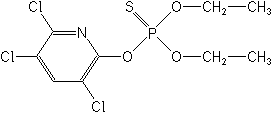-
Common NameChlorpyrifos
-
中文通用名毒死蜱
-
IUPACO,O-diethyl O-3,5,6-trichloro-2-pyridyl phosphorothioate
-
CASO,O-diethyl O-(3,5,6-trichloro-2-pyridinyl) phosphorothioate
-
CAS No.2921-88-2
-
Molecular FormulaC9H11Cl3NO3PS
-
Molecular Structure
-
Category
-
ActivityInsecticide
-
PremixSulfoxaflor+Chlorpyrifos
Spirotetramat+Chlorpyrifos
Pymetrozine+Chlorpyrifos
Permethrin+chlorpyrifos
Lambda-cyhalothrin+chlorpyrifos-methyl
Lambda-cyhalothrin+chlorpyrifos+Piperonyl butoxide
Lambda-cyhalothrin+chlorpyrifos
Imidacloprid+Chlorpyrifos+Difenoconazole
Imidacloprid+chlorpyrifos
Fipronil+Chlorpyrifos
Endosulfan+chlorpyrifos
Emamectin benzoate+Chlorpyrifos
Dinotefuran+Chlorpyrifos
Deltamethrin+chlorpyrifos-methyl
Deltamethrin+chlorpyrifos
Chlorpyrifos+cypermethrin
Chlorpyrifos+beta-cypermethrin
Bifenthrin+chlorpyrifos
Beta-cypermethrin+chlorpyrifos-methyl
Beta-cyfluthrin+Chlorpyrifos
Alpha-cypermethrin+chlorpyrifos
Acetamiprid+chlorpyrifos
Abamectin+Chlorpyrifos
Emulsifiable concentrate, dust, flowable, granular bait, wettable powder, microcapsule, pellet, spray. Premix Parters: deltamethrin; flucarbazone-sodium; methabenzthiazuron; metsulfuron-methyl; sulfentrazone sulfometuron-methyl.
-
Physical PropertiesMolecular weight:350.6; Physical form:Colourless crystals, with a mild mercaptan odour. Density:1.44 (20 °C); Melting point:42-43.5 °C; Vapour pressure:2.7 mPa (25 °C); Henry constant:6.76×10-1 Pa m3 mol-1 (calc.); Partition coefficient(n-octanol and water):logP = 4.7; Solubility:In water c. 1.4 mg/l (25 °C). In benzene 7900, acetone 6500, chloroform 6300, carbon disulfide 5900, diethyl ether 5100, xylene 5000, iso-octanol 790, methanol 450 (all in g/kg, 25 °C).; Stability:Rate of hydrolysis increases with pH, and in the presence of copper and possibly of other metals that can form chelates; DT50 1.5 d (water, pH 8, 25 °C) to 100 d (phosphate buffer). Soluble in acetone, benzene, chloroform, ethanol, iso-octane, methanol, and organic solvents.
-
ToxicologyOral:Acute oral LD50 for rats 135-163 mg/kg, guinea pigs 504 mg/kg, rabbits 1000-2000 mg/kg. Percutaneous:Acute percutaneous LD50 for rabbits >5000 mg/kg; (tech.) for rats >2000 mg/kg. Inhalation:LC50 (4-6 h) for rats >0.2 mg/l (14 ppb). Phytotoxicity:Non-phytotoxic to most plant species when used as recommended. Poinsettias, azaleas, camellias, and roses may be injured. ADI:(JMPR) 0.03 mg/kg b.w. [2000].
-
Environmental ProfileEcotoxicology:
Algae:NOEC for Selenastrum capricornutum >0.4 mg/l.Bees:Toxic to bees. LD50 (oral) 360 ng/bee; (contact) 70 ng/bee.Birds:Acute oral LD50 for mallard ducks 490 mg/kg, house sparrows (Passer domesticus) 122 mg/kg, chickens 32-102 mg/kg. Dietary LC50 (8 d) for bobwhite quail 423 ppm.Daphnia:LC50 (48 h) 1.7mg/l.Fish:LC50 (96 h) for goldfish 0.18 (24 h), bluegill sunfish 0.002-0.010 mg/l, rainbow trout 0.007-0.051 mg/l, roach 0.25 mg/l, fathead minnow 0.12-0.54 mg/l, mosquito fish < 1 mg/l.Worms:LC50 (14 d) for Eisenia foetida 210 mg/kg soil.Other aquatic spp.: LC50 for Korean shrimp (Palaemon macrodactylus) 0.05 mg/l.Other beneficial spp.:Toxic to Collembola (J. A. Wiles & G. K. Frampton, Pestic. Sci., 47, 273 (1996)). Environmental fate:
Animals:In rats, dogs, and other mammals, following oral administration, rapid metabolism occurs, the principal metabolite being 3,5,6-trichloropyridin-2-ol. Excretion is principally in the urine.Soil:In soil, chlorpyrifos is degraded at a moderate rate; DT50 (lab.) 10-120 d (25 °C); field DT50 for soil-incorporated applications 33-56 d, for soil-surface applications 7-15 d. Primary route of degradaPlant:Non-systemic in plants, not absorbed from soil via the roots. Residues taken up by plant tissues are metabolised to 3,5,6-trichloropyridin-2-ol which is conjugated and sequestered.WATER SOLUBILITY: 2 ppm at 25°C
-
Transport InformationSignal Word:CAUTION; Hazard Class:II (Moderately hazardous)
Porduct NewsMore
Colombia’s Constitutional Court bans chlorpyrifos
Argentina SENASA considering to ban chlorpyrifos
US EPA proposes new safety measures for chlorpyrifos
Certain plant pesticides banned in Switzerland from July
EU ban chlorpyrifos and chlorpyrifos-methyl
Chlorpyrifos Chlorpyrifos-methyl
California bans chlorpyrifos, all sales will end on Feb. 6, 2020
California advances ban on insecticide chlorpyrifos
Environmentalist sue US EPA over its approval of chlorpyrifos
‘No safe exposure level’ for chlorpyrifos, renewal unlikely, EFSA concluded
Australia APVMA proposed to remove home and garden uses of chlorpyrifos products
Related CompaniesMore
Country: India
Zinc phosphide Aluminium phosphide Profenofos Glyphosate Tebuconazole Chlorpyrifos Fluroxypyr Chlorpyrifos+cypermethrin Cypermethrin+profenofos Tebuconazole+Sulphur Sulphur
SINO CHEMTECH (SHANGHAI) CO., LTD
Country: China
Tribenuron-methyl Nicosulfuron Dimethomorph Clodinafop-propargyl Diazinon Emamectin benzoate Imidacloprid Thiamethoxam Chlorpyrifos+cypermethrin Bromoxynil octanoate+MCPA-isooctyl BAAPE IR3535
Anhui Fengle Agrochemical Co., Ltd.
Country: China
Tribenuron-methyl Dimethomorph Bentazone Carboxin Quizalofop-P-ethyl Nicosulfuron Clomazone Propiconazole Chlorpyrifos Clopyralid Clodinafop-propargyl
Lianyungang Liben Crop Science Co.,Ltd.
Country: China
Terbuthylazine Paraquat Atrazine Ametryn Prometryn Pyraclostrobin Isoprothiolane Simazine Azoxystrobin Chlorpyrifos Nitenpyram
SML Limited (Formerly known as Sulphur Mills Limited)
Country: India
Sulphur Imidacloprid Lambda-cyhalothrin Thiamethoxam+lambda-cyhalothrin Thiamethoxam Fipronil Tebuconazole Tebuconazole+Sulphur Clomazone Chlorpyrifos

 0
0 Subscribe
Subscribe
